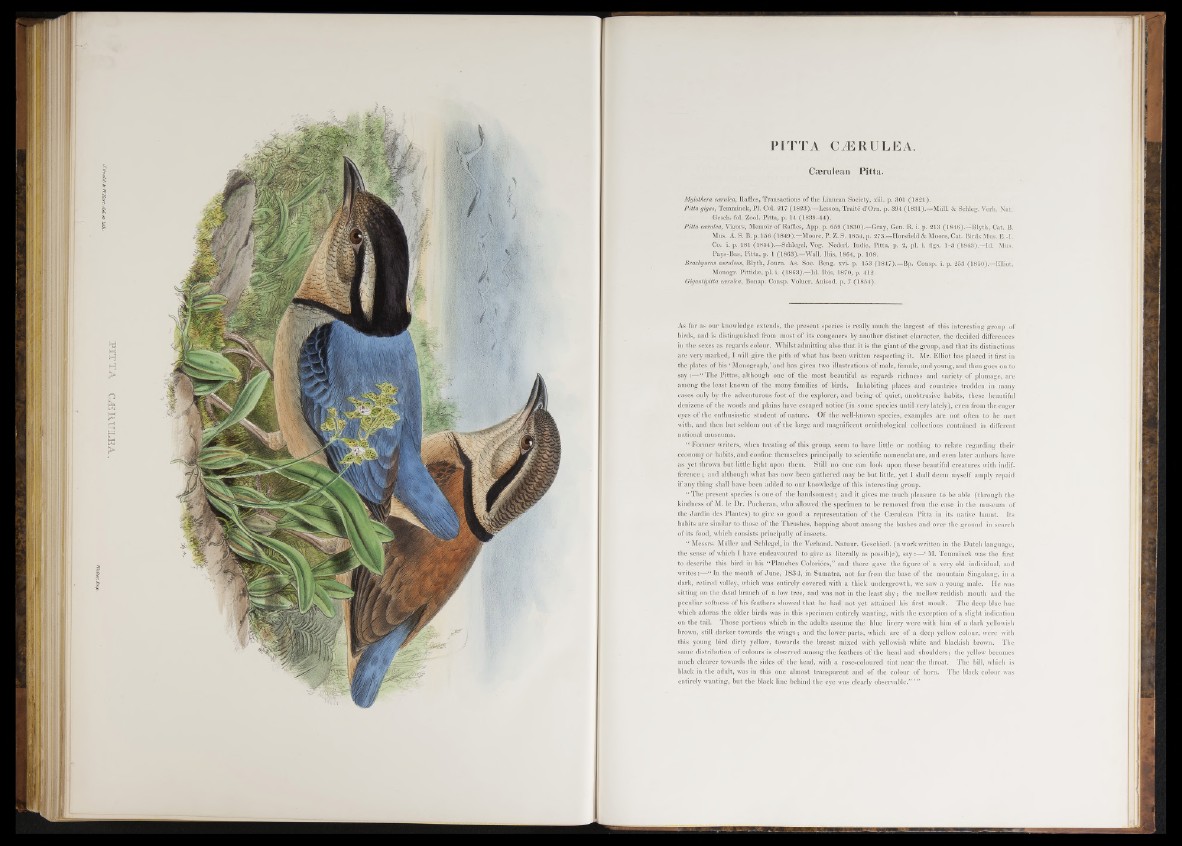
PITTA CÆRULEA.
Cærulean Pitta .
Myiothera ceerulea, Raffles, Transactions of th e Linnean Society, xiii. p. 301 ( 1821).
Pitta gigas, Temminck, Pl. Col. 217 (1823).—-Lesson,T ra ité d ’Orn. p. 394 (1831).—Müll. & Schleg. Verb. Nat.
Gesch. fol. Zool. Pitta, p. 14 (1839-44).
Pitta ceerulea, Vigors, Memoir of Raffles, App. p. 659 (1830).—Gray, Gen. B. i. p. 213 (18 4 6 ).—Blyth, Cat. B.
Mus. A. S. B. p. 156 (1849).—Moore, P. Z. S. 1854, p. 273..—Horsfield & Moore, Cat. Birds Mus. E.-I.
Co. i. p. 181 (1854).-—Schlegel, Vog. .Nederl. Indie, Pitta, p. 2, pl. i. figs. 1-3 (1863).^-Id. Mus.
Pays-Bas, P itta , p. 1 (1863).—Wall. Ibis, 1864, p. 108.
Brachyurus ceeruleus, Blyth, Journ. As. Soc. Beng. xvi. p. 153 (1847).—Bp. Consp. i. p. 253 (1850).—Elliot,
Monogr. Pittidæ, pl. i. (1863).—Id. Ibis, 1870, p. 412.
Gigantipitta ceerulea, Bonap. Consp. Volucr. Anisod. p. 7 (1854),
As far as our knowledge extends, the present species is really much the largest o f this interesting group of
birds, and is distinguished from most of its congeners by another distinct, character, the decided differences
in the sexes as regards colour. Whilst admitting also that it is the giant of the group, and that its distinctions
are very marked, I will give the pith of what has been written respecting it. Mr. Elliot has placed it first in
the plates of his ‘ Monograph,’ and has given two illustrations of male, female, and young, and then goes on to
say :— “ T he Pittas, although one of the most beautiful as regards richness and variety of plumage, are
among the least known of the many families of birds. Inhabiting places and countries trodden in many
cases only by the adventurous foot of the explorer, and being of quiet, unobtrusive habits, these beautiful
denizens of the woods and plains have escaped notice (in some species until .very lately), even from the eager
eyes of the enthusiastic student of nature. Of the well-known species, examples are not often to be met
with, and then but seldom out of the large and magnificent ornithological collections contained in different
national museums.
“ Former writers, when treating of this group, seem to have little or nothing to relate regarding their
economy or habits, and confine themselves principally to scientific nomenclature, and even later authors have
as yet thrown but little light upon them. Still no one can look upon these beautiful creatures with indifference
; and although what has now been gathered may be but little,, yet I shall deem myself amply repaid
if any thing shall have been added to our knowledge of this interesting group.
“ The present species is one of the handsomest ; and it gives me much pleasure to be able (through the
kindness of M. le Dr. Pucheran, who allowed the specimen to be removed from the case in the museum of
the Jardin des Plantes) to give so good a representation of the Cærulean Pitta , in its native haunt. Its
habits are similar to those of the Thrushes, hopping about among the bushes and over the ground in search
of its food, which consists principally of insects.
“ Messrs- Müller and Schlegel, in the Verhand. Natuur. Geschied. (a work written in. the Dutch language,
the sense of which I have endeavoured to give as literally as possible), say :•—‘ M. Temminck was the first
to describe this bird in his “ Planches Coloriées,” and there gave the figure of a very old individual, and
writes:— “ In the month of June, 1834, in Sumatra, not far from the base of the mountain Singalang, in a
dark, retired valley, which was entirely covered with a thick undergrowth, we saw a young male. He was
sitting on the dead branch of a low tree, and was not in the least shy ; the mellow reddish mouth and the
peculiar softness o f his feathers showed that he had not yet attained his first moult. The deep blue hue
which adorns the older birds was in this specimen entirely wanting, with the exception of a slight indication
on the tail. Those portions which in the adults assume the blue livery were with him of a dark yellowish
brown, still darker towards the wings ; and the lower parts, which are of a deep yellow colour, were with
this young bird dirty yellow, towards the breast mixed with yellowish white and blackish brown. The
same distribution of colours is observed among the feathers o f the head and shoulders; the yellow becomes
much clearer towards the sides of the head, with a rose-coloured tint near the throat. The bill, which is
black in the adult, was in this one almost transparent and of the colour of horn. The black colour was
entirely wanting, but the black line behind the eye was clearly observable.” ’ ”